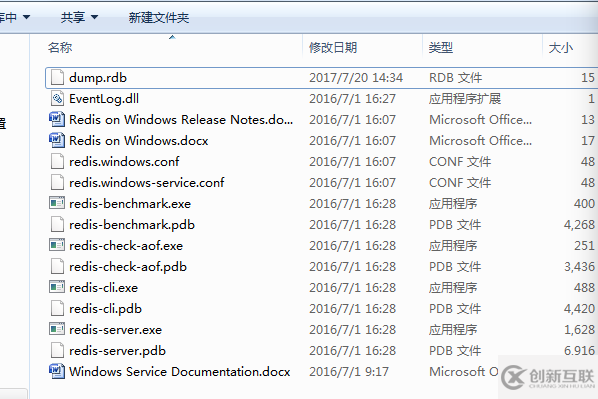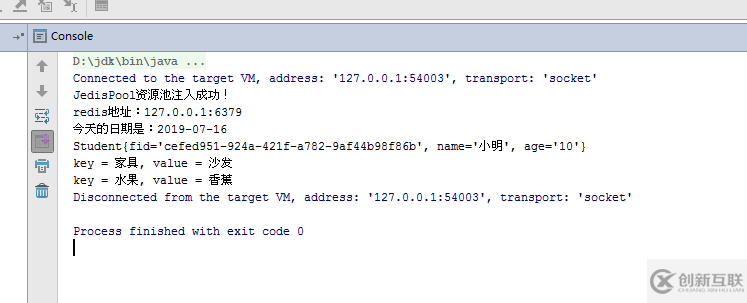Java中Redis如何使用
這篇文章給大家介紹Java中redis如何使用,內容非常詳細,感興趣的小伙伴們可以參考借鑒,希望對大家能有所幫助。
濱海新區ssl適用于網站、小程序/APP、API接口等需要進行數據傳輸應用場景,ssl證書未來市場廣闊!成為成都創新互聯的ssl證書銷售渠道,可以享受市場價格4-6折優惠!如果有意向歡迎電話聯系或者加微信:13518219792(備注:SSL證書合作)期待與您的合作!
1、安裝
Redis 支持 32 位和 64 位。這個需要根據你系統平臺的實際情況選擇,這里我們下載 Redis-x64-3.2.100.zip壓縮包,并解壓至磁盤指定文件夾

2、啟動
打開文件夾,內容如下:

雙擊redis-server啟動redis,這時Redis默認地址是127.0.0.1,端口號是6379
雙擊 redisclient-win32.x86.2.0.exe,即可運行,運行如圖
3、Java使用Redis
在maven下添加以下內容,引入jedis
<dependency> <groupId>redis.clients</groupId> <artifactId>jedis</artifactId> <version>2.9.0</version> </dependency>
編寫對象序列化與反序列化工具類
package com.jedis.util;
import java.io.ByteArrayInputStream;
import java.io.ByteArrayOutputStream;
import java.io.ObjectInputStream;
import java.io.ObjectOutputStream;
public class SerializeUtil {
/*
* 序列化
* */
public static byte[] serizlize(Object object){
ObjectOutputStream oos = null;
ByteArrayOutputStream baos = null;
try {
baos = new ByteArrayOutputStream();
oos = new ObjectOutputStream(baos);
oos.writeObject(object);
byte[] bytes = baos.toByteArray();
return bytes;
} catch (Exception e) {
e.printStackTrace();
}finally {
try {
if(baos != null){
baos.close();
}
if (oos != null) {
oos.close();
}
} catch (Exception e2) {
e2.printStackTrace();
}
}
return null;
}
/*
* 反序列化
* */
public static Object deserialize(byte[] bytes){
ByteArrayInputStream bais = null;
ObjectInputStream ois = null;
try{
bais = new ByteArrayInputStream(bytes);
ois = new ObjectInputStream(bais);
return ois.readObject();
}catch(Exception e){
e.printStackTrace();
}finally {
try {
if (ois != null) {
ois.close();
}
if(bais != null){
bais.close();
}
} catch (Exception e2) {
e2.printStackTrace();
}
}
return null;
}
}編寫Jedis工具類
package com.jedis.util;
import org.springframework.beans.factory.annotation.Autowired;
import org.springframework.beans.factory.annotation.Qualifier;
import org.springframework.stereotype.Component;
import redis.clients.jedis.Jedis;
import redis.clients.jedis.JedisPool;
import java.util.Map;
public class JedisComponent {
private JedisPool jedisPool;
public JedisComponent(JedisPool jedisPool){
this.jedisPool = jedisPool;
}
public void setObject(String key,Object object){
Jedis jedis = null;
try {
jedis = jedisPool.getResource();
jedis.set(key.getBytes(), SerializeUtil.serizlize(object));
} finally {
if (jedis != null) {
jedis.close();
}
}
}
public Boolean exists(String key){
Jedis jedis = null;
try {
jedis = jedisPool.getResource();
return jedis.exists(key);
} finally {
if (jedis != null) {
jedis.close();
}
}
}
public Object getObject(String key){
Jedis jedis = null;
try {
jedis = jedisPool.getResource();
byte[] bytes = jedis.get(key.getBytes());
return SerializeUtil.deserialize(bytes);
} finally {
if (jedis != null) {
jedis.close();
}
}
}
public void setMap(String key, Map map) {
Jedis jedis = null;
try {
jedis = jedisPool.getResource();
jedis.hmset(key,map);
} finally {
if (jedis != null) {
jedis.close();
}
}
}
public Map getMap(String key) {
Jedis jedis = null;
try {
jedis = jedisPool.getResource();
return jedis.hgetAll(key);
} finally {
if (jedis != null) {
jedis.close();
}
}
}
public void set(String key, String val) {
Jedis jedis = null;
try {
jedis = jedisPool.getResource();
jedis.set(key, val);
} finally {
if (jedis != null) {
jedis.close();
}
}
}
public String get(String key) {
Jedis jedis = null;
try {
jedis = jedisPool.getResource();
return jedis.get(key);
} finally {
if (jedis != null) {
jedis.close();
}
}
}
public void setKeyTime(String key,int time) {
Jedis jedis = null;
try {
jedis = jedisPool.getResource();
jedis.expire(key,time);
} finally {
if (jedis != null) {
jedis.close();
}
}
}
public void delKey(String key) {
Jedis jedis = null;
try {
jedis = jedisPool.getResource();
jedis.del(key);
} finally {
if (jedis != null) {
jedis.close();
}
}
}
public Long getKeyTime(String key) {
Jedis jedis = null;
try {
jedis = jedisPool.getResource();
return jedis.ttl(key);
} finally {
if (jedis != null) {
jedis.close();
}
}
}
public Long removeKeyTime(String key){
Jedis jedis = null;
try {
jedis = jedisPool.getResource();
return jedis.persist(key);
} finally {
if (jedis != null) {
jedis.close();
}
}
}
}編寫測試對象Student
package com.jedisTest;
import java.io.Serializable;
/**
* Created by Administrator on 2019/7/16 0016.
*/
public class Student implements Serializable{
private static final long serialVersionUID = 8562001374896568949L;
private String fid;
private String name;
private Integer age;
public String getFid() {
return fid;
}
public void setFid(String fid) {
this.fid = fid;
}
public String getName() {
return name;
}
public void setName(String name) {
this.name = name;
}
public Integer getAge() {
return age;
}
public void setAge(Integer age) {
this.age = age;
}
@Override
public String toString() {
return "Student{" +
"fid='" + fid + '\'' +
", name='" + name + '\'' +
", age='" + age + '\'' +
'}';
}
}最后編寫main方法測試
package com.jedisTest;
import redis.clients.jedis.JedisPool;
import redis.clients.jedis.JedisPoolConfig;
import java.util.HashMap;
import java.util.Map;
import java.util.UUID;
/**
* Created by Administrator on 2019/7/16 0016.
*/
public class JedisTest {
//路由
private static String host="127.0.0.1";
//端口號
private static int port=6379;
//超時
private static int timeout=10000;
// private String password="supermap";
//連接池最大連接數(使用負值表示沒有限制)
private static int maxActive=1024;
//連接池中的最大空閑連接
private static int maxIdle=200;
//連接池中最小空閑連接
private static int minIdle=0;
//最大等待
private static long maxWaitMillis=10000;
public static void main(String[] args){
JedisPool jedisPool = null;
try{
JedisPoolConfig jedisPoolConfig = new JedisPoolConfig();
jedisPoolConfig.setMaxIdle(maxIdle);
jedisPoolConfig.setMaxWaitMillis(maxWaitMillis);
jedisPoolConfig.setMaxTotal(maxActive);
jedisPoolConfig.setMinIdle(minIdle);
jedisPool = new JedisPool(jedisPoolConfig,host,port,timeout,null);
System.out.println("JedisPool資源池注入成功!");
System.out.println("redis地址:" + host + ":" + port);
JedisComponent jedisComponent = new JedisComponent(jedisPool);//實例化JedisComponent工具類
//字符串的操作
String today = "2019-07-16";
jedisComponent.set("date", today);//將字符串today存入Redis
String value = jedisComponent.get("date");//將key為date的value取出
System.out.println("今天的日期是:" + value);//打印value到控制臺
jedisComponent.setKeyTime("date",10);//給date設置過期時間,單位是秒
Boolean date = jedisComponent.exists("date");//判斷key為date的數據是否存在
jedisComponent.removeKeyTime("date");//刪除date的過期時間
jedisComponent.delKey("date");//刪除key為date的數據
//對象的操作
Student stuSave1 = new Student();
stuSave1.setFid(UUID.randomUUID().toString());
stuSave1.setName("小明");
stuSave1.setAge(10);
jedisComponent.setObject("stu1",stuSave1);//將stu1序列化存入Redis
Student stuGet1 = (Student) jedisComponent.getObject("stu1");//將stu1反序列化取出
System.out.println(stuGet1.toString());//打印stuGet1到控制臺
jedisComponent.setKeyTime("stu1",10);//給stu1設置過期時間,單位是秒
//Map集合操作
Map<String, String> map = new HashMap<>();//Redis只支持Map集合鍵值都為String類型的存取
map.put("水果","香蕉");
map.put("家具","沙發");
jedisComponent.setMap("map", map);//將map存入Redis
Map<String, String> map1 = jedisComponent.getMap("map");//將key為map從Redis取出
if(map1 != null){
for (Map.Entry<String, String> entry : map1.entrySet()) {
System.out.println("key = " + entry.getKey() + ", value = " + entry.getValue());
}
}
jedisComponent.delKey("map");//刪除key為map的數據
}catch (Exception e){
e.printStackTrace();
}finally {
jedisPool.close();//最后關閉JedisPool資源池
}
}
}控制臺輸出

關于Java中Redis如何使用就分享到這里了,希望以上內容可以對大家有一定的幫助,可以學到更多知識。如果覺得文章不錯,可以把它分享出去讓更多的人看到。
網站標題:Java中Redis如何使用
分享地址:http://www.yijiale78.com/article4/ghdjoe.html
成都網站建設公司_創新互聯,為您提供用戶體驗、定制開發、服務器托管、App設計、網站策劃、移動網站建設
聲明:本網站發布的內容(圖片、視頻和文字)以用戶投稿、用戶轉載內容為主,如果涉及侵權請盡快告知,我們將會在第一時間刪除。文章觀點不代表本網站立場,如需處理請聯系客服。電話:028-86922220;郵箱:631063699@qq.com。內容未經允許不得轉載,或轉載時需注明來源: 創新互聯

- 電子商務網站制作_電子商務解決方案 2013-11-19
- 移動通用實名撬動移動電子商務金礦 2021-04-28
- 電子商務問題,設計中的常見問題 2022-05-27
- 移動電子商務商機涌現電商寄望二次突破 2022-11-16
- 要做好電子商務 該從哪里著手 2021-06-26
- 電子商務網站制作要了解什么 2021-10-03
- 企業網站建設電子商務及全景技術 2022-04-27
- 電子商務網頁設計-結帳頁面設計 2019-11-25
- 電子商務5大內容管理系統 2016-08-20
- 電子商務前途決定你對它的了解認識 2021-05-05
- 上海網站建設如何成為電子商務平臺 2020-05-18
- 電子商務網站設計關鍵要素:可用性和美觀性 2022-02-20